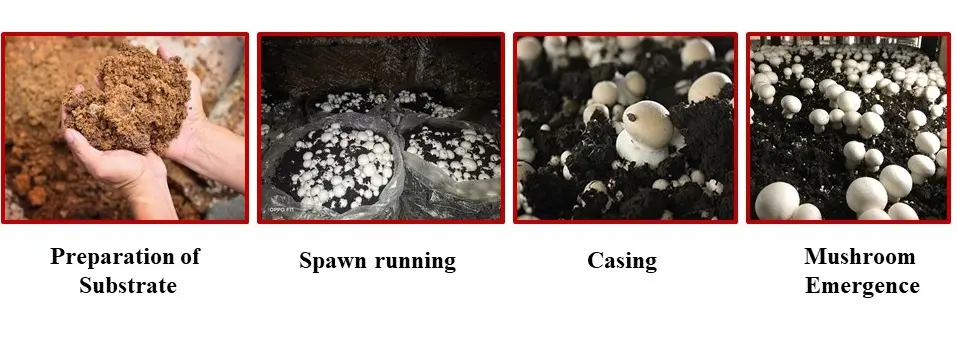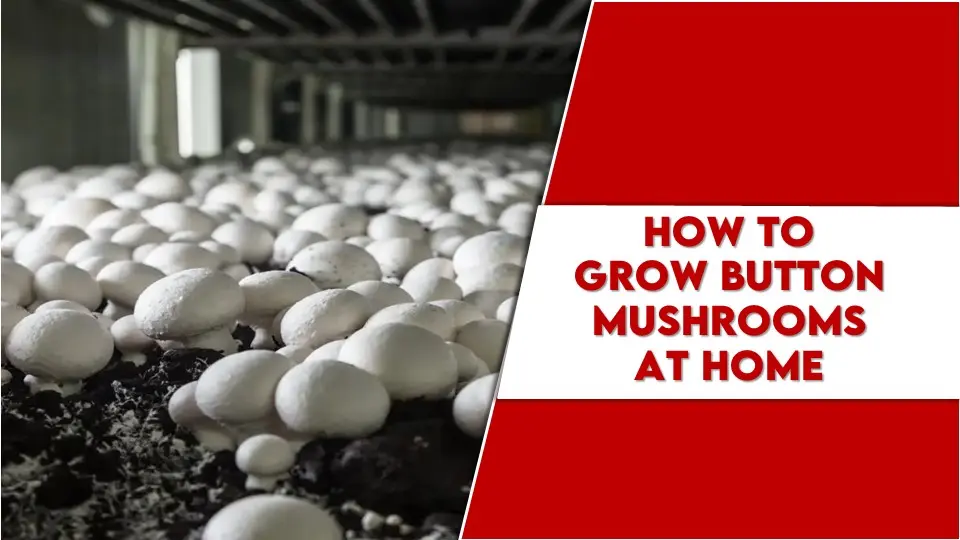Hello curious people ! What comes to your mind when you think of agriculture? The usual thoughts are field and vivid shades of green but in this article we’ve not included greens but a while of agriculture and to be specific, “white button mushrooms” also known as “Agaricus bisporus”. Its initial commercial cultivation started in the 17th century and mainly by small farmers and gradually farmers found out how to grow button mushrooms at home. This low calorie, healthy and maximum grown species of mushroom is remunerative not only for large scale farming industries but also for home gardeners and farmers as its cultivation does not have enormous requirements and has a good return on investment.
Interesting Fact about Button Mushrooms
- White button mushrooms are called so when they’re at the earliest stage of maturity, little later they’re known as cremini mushrooms which have slightly brown caps and when at the last stage of maturity, they’re called Portobello mushrooms. That means, scientifically they’re all “Agaricus bisporus”
- Its nutritional contents are more appealing than its appearance.100 grams of button mushrooms have only 0 to 0.5 grams of fat, approximately 4 grams of protein, high selenium, folate, vitamin D and many more, they’re also low in calories.
- Button mushrooms are also said to have anticancer properties because of the presence of antioxidant compounds present in them and also take care of the heart .
Also Read
Steps to Grow Button mushroom at home
- Spot selection
- Spawn production or buying readymade spawn
- Preparation of substrate or compost for spawning
- Inoculation or spawning
- Spawn running
- Casing by peat or damp potting
- Fruiting or mushroom emergence
Only superficially knowing the steps isn’t enough, so let’s comprehend each one and see how to grow button mushrooms at home:-
Spot Selection
Abiding to the first step gives life to the subsequent steps. Mushroom cultivation requires cold indoors with no sunlight penetration, therefore it is very much winter suitable and if you’re wondering how to grow button mushrooms at home when it’s sunny outside, simply choose basements, dark cupboards as growing spots. Plants usually need sunlight for photosynthesis which occurs only when chlorophyll is present but because this botanical species does not have chlorophyll, it doesn’t require sunlight.
Spawn production or buying readymade spawn
As seed is to plant, spores are to mushrooms and spawn is spores mixed with nutrients but for a layman’s language these can be called ‘seeds’ in the market. Home gardeners or farmers rarely produce spawns at home as it’s more convenient to buy them directly from the market or local nurseries. Prefer buying spawns mixed with substrates like hay, sawdust etc. when you’re growing button mushrooms at home. But we can briefly understand about its production at home :-
Use sterilized grains (usually rye and wheat are preferred) which will act as growing medium for the mycelium of button mushrooms, grain sterilization is done by boiling them as it will kill other microbes present in them and only mycelium growth will be supported. Now introduce mushroom spores or pre-existing spawns into it which will act as inoculum.
Preparation of substrate or compost for spawning
As soil is to field crops, compost is to mushrooms. Compost is the substrate or feed bed for growing this highly economically beneficial crop and it has to be created meticulously as this solely has the feed for the growing mushrooms, here button mushrooms. The Agaricus species we’re cultivating is a secondary decomposer, i.e, it will act on an already partially decomposed substrate. Our compost must be nitrogen rich and other sources that should be present are carbon sources, carbohydrate materials, gypsum, newspaper and vermiculite. Usually horse manure along with straw is used as substrate, horse manure is made by storing horse bedding for 3-4 weeks. This compost contains horse manure and straw in equal amounts with a minute quantity of gypsum for texture and pH balance should be turned in 2-3 days for better aeration . This compost should be heated before inoculating the spawns into it for sterilization purposes.
Inoculation or spawning
Spawning refers to the mixing of spawns with the compost. The container chosen for mushroom cultivation should be filled with the compost leaving 1-1.5 inches space on the top. Now it’s time to spread the spawn layer of button mushrooms evenly throughout the compost and cover it with a thin layer of compost and mist water over it. Know that the inoculation should be layered i.e, one thick layer of compost and another of spawn and this can be continued according to the bag size. The temperature indoors where they’re set to grow should have a temperature of approximately 30°C during the growth period which can be maintained with heaters and remember to spray water on the compost everyday.
Spawn running
It’s the spread of mycelium from the inoculated spawn of button mushrooms. It spreads throughout the substrate and will lead to Mycelium, which refers to a group of fungal filaments and is the vegetative part of fungus. This mycelium uptakes nutrients from the substrate and supports the growth of the fungal body. A white webbed network is the sign of mycelium growth which might take a few weeks when you’re growing button mushrooms at home or on a large scale.
Casing
This is a crucial step for inducing fruiting in button mushrooms. After spawn run the top surface is again covered with approximately 4 cm of soil or any other casing material which should be made sterile by heating if it isn’t already, should have an appropriate pH and should be damp or damped by misting water over it, it should have better porosity and water retention capacity. The process of sterilization and pasteurization of casing material should start 2 weeks prior to its application. After its application, it should be brought back to cool temperature as required for its cultivation i.e, 23-27°C. Casing develops an environment naturally required for button mushrooms to flourish/fruit.
Some casing materials are :-
a.) One material that you’ll be recommended everywhere is “peat moss”. It has moisture retention capacity, pores enough for ventilation or air spaces which helps in faster growth of button mushrooms.
b.) Well decomposed FYM (Farm yard manure) that is a few years old (preferably 2-3 years old) is also used making growth of button mushrooms at home easier and faster.
c.) FYM can also be used by mixing it with other materials like burnt rice husk, loam soil or Calcium carbonate.
Fruiting or Mushroom Emergence
After 2-3 weeks of casing, you’ll observe tiny pinheads of Agaricus bisporus or button mushrooms and they’ll grow into a round cap or button-like structure and 3-4 cm in diameter. How to harvest them ? It’s simple, hold them from the cap with the help of your thumb on one side and fingers on the other, twist them and tadaaa.. you’ve fresh home grown mushrooms with you.

Also Read
Insect-Disease Management in Button Mushroom
How to grow button mushrooms at home?” This question has been answered but “How to keep them disease free?” is yet to answered. Button mushrooms like other botanical species are also prone to disease and pest infestation especially when you’re growing them at home and therefore compost sanitation and heating process at many steps was mentioned. Some common diseases are :-
- Green mould :- Light to dark green unevenly coloured patches are seen on spawn. It affects pin formation. It can be managed by using baking soda, citric acid, hydrogen peroxide solutions on affected areas. 0.5% Benlate can be sprayed.
- Soft mildew (cobweb) :- A cottony white mould which further converts into pink grows on the soil surface. For its management, excessive moisture should be avoided and proper ventilation must be present.
- Bubble disease :- The cap of button mushrooms and stalk becomes almost the same size because of swollen stalks and reduced cap size. Pasteurize the compost well to avoid this disease.
- Bacterial blotch :- Button Mushroom caps show brownish spot or blotch like appearance. Soil sanitation measures should be taken and chlorine water is also beneficial.
Also Read
- Gucchi Mushroom Benefits That You Didn’t Know
- Mushroom Veg or Non Veg?
- How to Grow Shimeji Mushrooms
Conclusion
Farming isn’t only about paddy, wheat or monoculture, there are many more crops and species which can be cultivated along with them for achieving financial targets and mushroom is one of them, especially button mushroom which is easy to grow at home and approximately 90% of mushrooms cultivated are button mushrooms. With high nutritional value, they possess high economic value in the international market as well and with readily available resources, it has become easier to cultivate them at home as well. There have been many success stories of people who learnt how to grow button mushrooms at home and they started its cultivation from home and later it became a widened business. So let’s give these mushrooms a chance to work for their potential. Thank you. Toodles !
Latest Post
- September Issue 2025- Times of Agriculture Magazine
- Top 15 Fertilizer Companies in the World
- Top 10 Vegetable Farming Profit Per Acre in India
- August 2025 : Times of Agriculture Magazine (AgriVoltaics Farming)
- Button Mushroom Farming: Infrastructure, Cultivation, and Profitability
- Sahiwal Cow: Characteristics, Milk per Day, Price and Origin
- July 2025 : Times of Agriculture Magazine
- June Issue (2025) – Times of Agriculture Magazine
- How to Create Modern Commercial Greenhouse Agriculture
- REACH NEW HEIGHTS WITH YOUR BUSINESS AT VIETSTOCK EXPO & FORUM 2025
- Revamping Waste: A wish list This World Environment Day
- Types of Banana in India : Health & wallet friendly fruit














